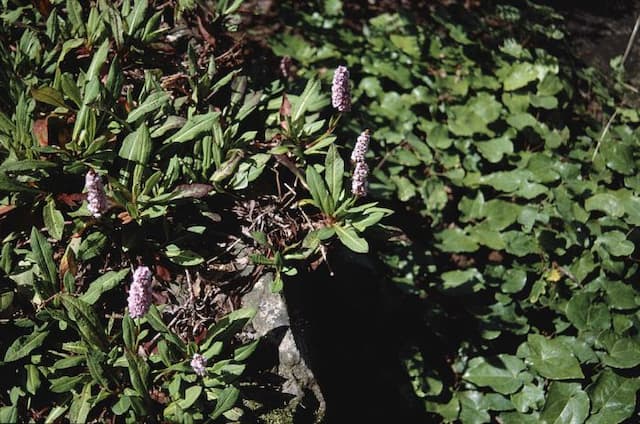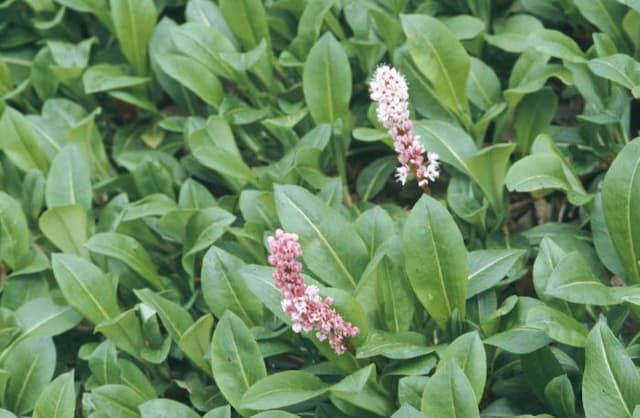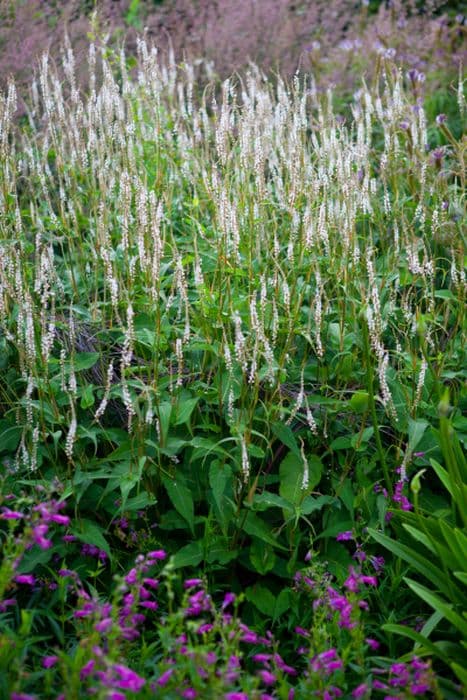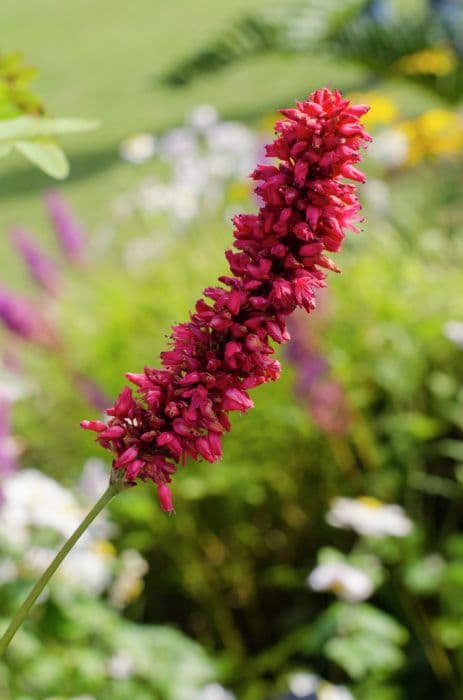Chinese rhubarb Rheum palmatum 'Atrosanguineum'

ABOUT
Rheum palmatum 'Atrosanguineum', commonly known as Red-veined Chinese rhubarb, is a striking ornamental plant noted for its large, bold leaves and vibrant floral displays. The leaves are the most distinctive aspect of this plant, with a deep, rich green color and conspicuously red-veined undersides, providing a dramatic contrast. These leaves are quite large and hand-shaped with pointed lobes, resembling the palm of an open hand. As the seasons change, the leaves can take on a redder hue, adding to the plant's ornamental value. In addition to its impressive foliage, Red-veined Chinese rhubarb sports tall flower stalks that rise above the foliage, bearing small, star-shaped flowers. The flowers are typically a deep red or burgundy color, forming dense clusters along the vertical spike, creating an eye-catching display that can add a touch of drama to any garden setting. Overall, the plant exudes a robust, architectural quality, making it a popular choice for gardeners looking to make a bold statement with their plant selection. The combination of its large, decorative leaves and striking flower spikes makes it a focal point when in bloom.
About this plant
 Names
NamesFamily
Polygonaceae.
Synonyms
Chinese Rhubarb, Ornamental Rhubarb, Turkish Rhubarb, Red-veined Pie Plant.
Common names
Rheum officinale Baill., Rheum tanguticum Maxim. ex Balf., Rheum palmatum var. tanguticum (Maxim. ex Balf.) Hook. f., Rheum emodi Wall. ex Meisn.
 Characteristics
CharacteristicsLife cycle
Perennials
Foliage type
Deciduous
Color of leaves
Green
Flower color
Red
Height
6 feet (1.83 meters)
Spread
3 feet (0.91 meters)
Plant type
Herb
Hardiness zones
5
Native area
China
Benefits
 General Benefits
General Benefits- Ornamental Value: Rheum palmatum 'Atrosanguineum', commonly known as ornamental rhubarb, is valued for its large, bold leaves and striking red stalks, making it a dramatic addition to garden landscapes.
- Drought Tolerance: Once established, ornamental rhubarb has good drought tolerance, making it suitable for gardens with less frequent watering.
- Cold Hardiness: This plant is able to withstand cold temperatures, making it suitable for planting in temperate regions with harsh winters.
- Growth Habit: With its upright growth habit, Rheum palmatum 'Atrosanguineum' can create structure and height in floral arrangements and garden designs.
- Suitable for Large Spaces: Given its size, ornamental rhubarb is ideal for filling large spaces in gardens, parks, or public areas, providing a lush, tropical look.
- Attracts Wildlife: The flowers of ornamental rhubarb are attractive to bees and other pollinators, making it a beneficial plant for supporting local ecosystems.
- Foliage Contrast: The dark red to purple foliage offers a striking contrast when planted alongside green-leaved plants, enhancing the visual appeal of mixed borders.
- Seasonal Interest: Ornamental rhubarb provides interest throughout the growing season, with foliage in the spring and summer, and decorative seed heads in the fall.
 Medical Properties
Medical Properties- Laxative effect – Contains anthraquinones which stimulate bowel movements.
- Antimicrobial activity – Exhibits potential against certain bacteria and fungi.
- Anti-inflammatory properties – May reduce inflammation in various conditions.
- Gastrointestinal benefits – Traditionally used in treating digestive disorders.
- Hepatoprotective potential – May offer some protection to the liver.
 Air-purifying Qualities
Air-purifying QualitiesThis plant is not specifically known for air purifying qualities.
 Other Uses
Other Uses- Ornamental Value: Rheum palmatum 'Atrosanguineum', commonly known as Chinese rhubarb, is often used in garden design for its bold foliage and striking appearance, which can add a dramatic accent to perennial borders or container plantings.
- Dye Production: The roots of the Chinese rhubarb can be used to produce a natural dye, which yields a rich brown or yellow color depending on the mordant used in the dyeing process.
- Fabric Printing: In traditional textile arts, the Chinese rhubarb root extract has been utilized for printing designs onto fabrics due to its color properties.
- Tannin Source: The roots contain tannins, which can be extracted and used in the leather tanning industry to provide color and texture to hides.
- Culinary Coloring Agent: While different from the edible rhubarb stalks, the root of Chinese rhubarb can impart color to foods, although primarily not used due to its strong flavor and potential toxicity.
- Photography: Historically, Chinese rhubarb has been used in the preparation of certain photographic chemicals, contributing to image development processes.
- Papermaking: The fibers from the Chinese rhubarb stalks can be included in paper manufacturing, lending the paper a unique texture and color.
- Potpourri Ingredient: Dried segments of Chinese rhubarb stalks can contribute an unusual texture and added bulk to potpourri mixes.
- Fish Poison: In some traditional practices, Chinese rhubarb has been used to poison water to stun or kill fish, making them easier to catch.
- Companion Planting: Due to its deep roots and large canopy, Chinese rhubarb can help provide shade and maintain soil structure when used in companion planting strategies in the garden.
Interesting Facts
 Feng Shui
Feng ShuiThe plant Chinese rhubarb is not used in Feng Shui practice.
 Zodiac Sign Compitability
Zodiac Sign CompitabilityThe plant Chinese rhubarb is not used in astrology practice.
 Plant Symbolism
Plant Symbolism- Healing: Rheum palmatum, commonly known as Chinese rhubarb, is valued in traditional medicine for its healing properties, particularly for digestive issues.
- Cleansing: As a plant known for its purgative effects, Chinese rhubarb symbolizes cleansing and the removal of toxins from the body.
- Bitterness: The bitter taste of the plant's roots reflects life's challenges and the overcoming of difficult situations.
- Transformation: The way Chinese rhubarb is processed for medicinal uses represents transformation and the importance of preparation and refinement in achieving one’s goals.
 Water
WaterFor the Chinese rhubarb, ensure the soil is consistently moist without being waterlogged. During the growing season, water the plant generously every week with approximately 1 inch of water. Adjust the amount during hot, dry periods, possibly increasing to about 1.5 inches weekly. During the dormant season, reduce watering to prevent the soil from becoming too soggy, possibly to around half an inch per week. Always allow the top inch of soil to dry out before watering again to prevent root rot.
 Light
LightChinese rhubarb thrives best in a location with full sun to partial shade. Ideally, provide it with early morning sunlight and some partial shade during the hottest part of the day to prevent leaf scorch. Avoid deep shade as this reduces the vigor and size of the plant.
 Temperature
TemperatureChinese rhubarb prefers temperate climates and can tolerate a temperature range from about 40°F to 75°F. The ideal growing temperature is between 50°F and 70°F. It's a hardy plant that can withstand cold down to about 5°F, but prolonged exposure to temperatures below freezing can damage the plant.
 Pruning
PruningChinese rhubarb benefits from pruning to remove spent flowers and dead leaves, which encourages new growth and maintains the plant's appearance. Prune it in late autumn or early winter, after the plant has gone dormant. Cut back the flower stalks to the base, and also remove any damaged or unhealthy foliage during this time.
 Cleaning
CleaningAs needed
 Soil
SoilChinese Rhubarb prefers a soil pH of 6.0 to 6.8. A well-draining, loamy soil rich in organic matter with some added aged compost or manure is ideal to encourage healthy growth. The soil should retain moisture but not become waterlogged.
 Repotting
RepottingChinese Rhubarb does not need frequent repotting and can thrive in the same pot for several years. It is typically repotted once it outgrows its container or once every 3 to 5 years to refresh the soil.
 Humidity & Misting
Humidity & MistingChinese Rhubarb prefers moderate humidity levels but is quite adaptable and does not require specific humidity conditions when grown outdoors in its ideal environment.
 Suitable locations
Suitable locationsIndoor
Provide bright light, cool temperature, and moist soil.
Outdoor
Place in partial shade, enrich soil, and ensure good drainage.
Hardiness zone
5-9 USDA
 Life cycle
Life cycleThe plant commonly known as Chinese rhubarb or ornamental rhubarb begins its life cycle as a seed, which, upon germinating in the soil, starts to develop a root system and a small shoot. As the shoot emerges from the soil, leaves start to unfurl, and the plant enters its vegetative growth stage, forming a rosette of large, deeply lobed, dark red to green leaves with red veins. Over time, typically in the second year, the Chinese rhubarb may produce a tall flower stalk in late spring or early summer, featuring small white or red flowers that are arranged in large, conical panicles. After pollination, these flowers develop into triangular winged fruits that contain seeds, allowing for the dispersal and continuation of the species. Once the flowering and fruiting are completed, the plant may die back to the ground in areas with cold winters, entering dormancy. With the arrival of warmer temperatures in spring, the Chinese rhubarb re-emerges from its rootstock, repeating its life cycle.
 Propogation
PropogationPropogation time
Spring-Early Summer
For the plant commonly known as Chinese rhubarb or ornamental rhubarb, Rheum palmatum 'Atrosanguineum', propagation is often best undertaken in the spring or early summer as the plant emerges from dormancy. The most popular method of propagation for this large, herbaceous perennial is by division. To propagate by division, carefully lift the parent plant from the ground using a garden fork, minimizing damage to the root system. Once the plant is out of the ground, portions of the crown that have multiple growth buds can be separated using a sharp knife or spade. Each division should have at least one strong bud and a portion of the root system attached. These divisions can then be immediately replanted in well-draining soil, spaced at least 3 feet (about 91 centimeters) apart to accommodate their eventual size. Water the new divisions well to help establish them, but be cautious of overwatering which can lead to root rot.






![Red bistort [Taurus]](/_next/image?url=https%3A%2F%2Fplants-admin.emdemapps.com%2Fimages%2Fplants%2F%2Fimages%2F604b548be7841.png&w=640&q=75)


